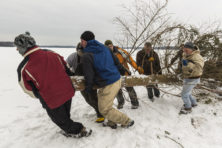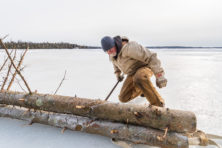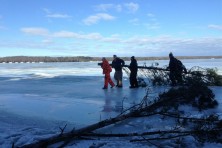Fish Sticks In Kangaroo Lake
- Share
- Tweet
- Pin
- Share
Members of the Kangaroo Lake Association will gather on Valentine’s Day to place fish sticks at eight locations around the lake.
No, not the breaded processed frozen food. These fish sticks are mid-sized trees that will be harvested in a tree-thinning program on Nature Conservancy property on the lake. They will be dragged to the eight locations around the lake and secured to eventually become part of the lake’s ecosystem.
“It’s a good common sense approach to restore some of the shoreline that has changed on the lake,” said Tom Schneider, president of the Kangaroo Lake Association.
Schneider first heard about the fish sticks concept during a presentation at the annual Wisconsin Lake Partnership Conference. Then about 18 months ago the association consulted with five representatives of the Wisconsin Department of Natural Resources who have interest in and knowledge of Kangaroo Lake. Association members didn’t want a study – they wanted results to improve the quality of the lake.
Out of that consultation came the idea for planting bulrushes and adding fish sticks to the Kangaroo Lake shoreline. Schneider wrote for and received $3,000 Shoreline Preservation Grant from the DNR.
“The Fish Sticks project attempts to balance homeowners’ desire to enjoy their lake property with habitat and shoreline where aquatic plants, large and small fish, birds, reptiles, animals and all of nature in general can thrive,” said Schneider.
The work begins Saturday morning when Harbor Lumber of Baileys Harbor will cut and drag the trees from the Nature Conservancy property to the lake. Volunteers will move trees by hand and with ATVs across the ice and place and secure them in eight locations. Each location will have a fish stick complex of two trees placed perpendicular to the shoreline, crossed and secured to each other and to the shoreline with cable to prevent movement after ice-out when they will sink into the lake.
“This innovative conservation project will have multiple benefits for Kangaroo Lake,” said Mike Grimm, conservation ecologist with The Nature Conservancy. “The partially submerged trees will provide habitat for many fish and invertebrates in the lake, protect the shoreline from wave erosion, provide calmer waters where submerged plants can get established, providing even more habitat for fish and other creatures. They will also provide resting and feeding sites for frogs, turtles, dragonflies and many lakeshore birds, particularly flycatchers and kingfishers.”
A study conducted by the University of Wisconsin’s Center for Limnology in northern Wisconsin and Upper Michigan showed there are significantly more trees and other woody debris in undeveloped lakes than in developed lakes. Ninety-two percent of the life in a lake has its origin at the shoreline. When logs and trees are absent in the water at the shoreline, the number and size of fish decline. Songbirds disappear from the shoreline, frogs and turtles are all but eliminated and healthy aquatic plants are reduced significantly.
Schneider said he and his wife surveyed the lake
This approach to protect shoreline and improve fish habitat has been used successfully in other places, including Douglas and Bayfield counties where it helped reduce the impact of developments on lake shorelines.




